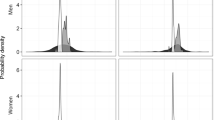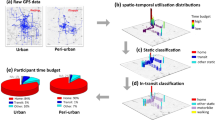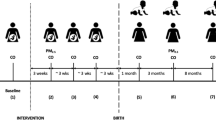Abstract
Background
Personal monitoring can estimate individuals’ exposures to environmental pollutants; however, accuracy depends on consistent monitor wearing, which is under evaluated.
Objective
To study the association between device wearing and personal air pollution exposure.
Methods
Using personal device accelerometry data collected in the context of a randomized cooking intervention in Ghana with three study arms (control, improved biomass, and liquified petroleum gas (LPG) arms; N = 1414), we account for device wearing to infer parameters of PM2.5 and CO exposure.
Results
Device wearing was positively associated with exposure in the control and improved biomass arms, but weakly in the LPG arm. Inferred community-level air pollution was similar across study arms (~45 μg/m3). The estimated direct contribution of individuals’ cooking to PM2.5 exposure was 64 μg/m3 for the control arm, 74 μg/m3 for improved biomass, and 6 μg/m3 for LPG. Arm-specific average PM2.5 exposure at near-maximum wearing was significantly lower in the LPG arm as compared to the improved biomass and control arms. Analysis of personal CO exposure mirrored PM2.5 results.
Conclusions
Personal monitor wearing was positively associated with average air pollution exposure, emphasizing the importance of high device wearing during monitoring periods and directly assessing device wearing for each deployment.
Significance
We demonstrate that personal monitor wearing data can be used to refine exposure estimates and infer unobserved parameters related to the timing and source of environmental exposures.
Impact statements
In a cookstove trial among pregnant women, time-resolved personal air pollution device wearing data were used to refine exposure estimates and infer unobserved exposure parameters, including community-level air pollution, the direct contribution of cooking to personal exposure, and the effect of clean cooking interventions on personal exposure. For example, in the control arm, while average 48 h personal PM2.5 exposure was 77 μg/m3, average predicted exposure at near-maximum daytime device wearing was 108 μg/m3 and 48 μg/m3 at zero daytime device wearing. Wearing-corrected average 48 h personal PM2.5 exposures were 50% lower in the LPG arm than the control and improved biomass and inferred direct cooking contributions to personal PM2.5 from LPG were 90% lower than the other arms. Our recommendation is that studies assessing personal exposures should examine the direct association between device wearing and estimated mean personal exposure.
This is a preview of subscription content, access via your institution
Access options
Subscribe to this journal
Receive 6 print issues and online access
$259.00 per year
only $43.17 per issue
Buy this article
- Purchase on Springer Link
- Instant access to full article PDF
Prices may be subject to local taxes which are calculated during checkout




Similar content being viewed by others
Data availability
Anonymized data that underlie this study are available upon request. Proposals should be directed to kwakupoku.asante@kintampo.khrc.org and to darby.jack@columbia.edu. To gain access, requestors will need to sign a data access agreement.
References
Steinle S, Reis S, Sabel CE. Quantifying human exposure to air pollution—Moving from static monitoring to spatio-temporally resolved personal exposure assessment. Sci Total Environ. 2013;443:184–93.
Nieuwenhuijsen M, Paustenbach D, Duarte-Davidson R. New developments in exposure assessment: the impact on the practice of health risk assessment and epidemiological studies. Environ Int. 2006;32:996–1009.
Weis BK, Balshaw D, Barr JR, Brown D, Ellisman M, Lioy P, et al. Personalized Exposure Assessment: Promising Approaches for Human Environmental Health Research. Environ Health Perspect. 2005;113:840–8.
Lawless P, Thornburg J, Rodes C, Williams R. Personal exposure monitoring wearing protocol compliance: An initial assessment of quantitative measurement. J Expo Sci Environ Epidemiol. 2012;22:274–80.
Baumgartner J, Carter E, Schauer JJ, Ezzati M, Daskalopoulou SS, Valois M-F et al. Household air pollution and measures of blood pressure, arterial stiffness and central haemodynamics. Heart. 2018:104;1515–21.
Baumgartner J, Clark S, Carter E, Lai A, Zhang Y, Shan M, et al. Effectiveness of a Household Energy Package in Improving Indoor Air Quality and Reducing Personal Exposures in Rural China. Environ Sci Technol. 2019;53:9306–16.
Milà C, Salmon M, Sanchez M, Ambrós A, Bhogadi S, Sreekanth V, et al. When, Where, and What? Characterizing Personal PM2.5 Exposure in Periurban India by Integrating GPS, Wearable Camera, and Ambient and Personal Monitoring Data. Environ Sci Technol. 2018;52:13481–90.
Ebelt ST, Petkau AJ, Vedal S, Fisher TV, Brauer M. Exposure of Chronic Obstructive Pulmonary Disease Patients to Particulate Matter: Relationships between Personal and Ambient Air Concentrations. J Air Waste Manag Assoc. 2000;50:1081–94.
Brook RD. Cardiovascular effects of air pollution. Clin Sci. 2008;115:175–87.
Chartier R, Phillips M, Mosquin P, Elledge M, Bronstein K, Nandasena S, et al. A comparative study of human exposures to household air pollution from commonly used cookstoves in Sri Lanka. Indoor Air. 2017;27:147–59.
Ha S, Nobles C, Kanner J, Sherman S, Cho S-H, Perkins N, et al. Air Pollution Exposure Monitoring among Pregnant Women with and without Asthma. Int J Environ Res Public Health. 2020;17:4888.
Zhao W, Hopke PK, Gelfand EW, Rabinovitch N. Use of an expanded receptor model for personal exposure analysis in schoolchildren with asthma. Atmos Environ. 2007;41:4084–96.
Rodes CE, Lawless PA, Thornburg JW, Williams RW, Croghan CW. DEARS particulate matter relationships for personal, indoor, outdoor, and central site settings for a general population. Atmos Environ. 2010;44:1386–99.
Bennitt FB, Wozniak SS, Causey K, Burkart K, Brauer M. Estimating disease burden attributable to household air pollution: new methods within the Global Burden of Disease Study. Lancet Glob Health. 2021;9:S18.
Lee AG, Kaali S, Quinn A, Delimini R, Burkart K, Opoku-Mensah J et al. Prenatal Household Air Pollution is Associated with Impaired Infant Lung Function with Sex-Specific Effects: Evidence from GRAPHS, a Cluster Randomized Cookstove Intervention Trial. Am J Respir Crit Care Med. 2018. https://doi.org/10.1164/rccm.201804-0694OC.
Lee KK, Bing R, Kiang J, Bashir S, Spath N, Stelzle D, et al. Adverse health effects associated with household air pollution: a systematic review, meta-analysis, and burden estimation study. Lancet Glob Health. 2020;8:e1427–e1434.
Smith KR, Bruce N, Balakrishnan K, Adair-Rohani H, Balmes J, Chafe Z, et al. Millions Dead: How Do We Know and What Does It Mean? Methods Used in the Comparative Risk Assessment of Household Air Pollution. Annu Rev Public Health. 2014;35:185–206.
Clark ML, Peel JL, Balakrishnan K, Breysse PN, Chillrud SN, Naeher LP, et al. Health and Household Air Pollution from Solid Fuel Use: The Need for Improved Exposure Assessment. Environ Health Perspect. 2013;121:1120–8.
Jack DW, Asante KP, Wylie BJ, Chillrud SN, Whyatt RM, Ae-Ngibise KA et al. Ghana randomized air pollution and health study (GRAPHS): study protocol for a randomized controlled trial. Trials. 2015;16. https://doi.org/10.1186/s13063-015-0930-8.
Chillrud SN, Ae-Ngibise KA, Gould CF, Owusu-Agyei S, Mujtaba M, Manu G, et al. The effect of clean cooking interventions on mother and child personal exposure to air pollution: results from the Ghana Randomized Air Pollution and Health Study (GRAPHS). J Expo Sci Environ Epidemiol. 2021;31:683–98.
Jack DW, Ae-Ngibise KA, Gould CF, Boamah-Kaali E, Lee AG, Mujtaba MN, et al. A cluster randomised trial of cookstove interventions to improve infant health in Ghana. BMJ Glob Health. 2021;6:e005599.
Kinney PL, Asante K-P, Lee AG, Ae-Ngibise KA, Burkart K, Boamah-Kaali E, et al. Prenatal and Postnatal Household Air Pollution Exposures and Pneumonia Risk: Evidence From the Ghana Randomized Air Pollution and Health Study. Chest. 2021;160:1634–44.
Quinn AK, Adjei IA, Ae-Ngibise KA, Agyei O, Boamah-Kaali EA, Burkart K, et al. Prenatal household air pollutant exposure is associated with reduced size and gestational age at birth among a cohort of Ghanaian infants. Environ Int. 2021;155:106659.
Quinn AK. Modifiable Risk in a Changing Climate: Linking household-level temperature, humidity, and air pollution to population health. 2016. https://academiccommons.columbia.edu/doi/10.7916/D83F4PWW (accessed 11 Sep 2019).
Quinn AK, Ae-Ngibise KA, Jack DW, Boamah EA, Enuameh Y, Mujtaba MN, et al. Association of Carbon Monoxide exposure with blood pressure among pregnant women in rural Ghana: evidence from GRAPHS. Int J Hyg Environ Health. 2016;219:176–83.
Van Vliet EDS, Asante K, Jack DW, Kinney PL, Whyatt RM, Chillrud SN, et al. Personal exposures to fine particulate matter and black carbon in households cooking with biomass fuels in rural Ghana. Environ Res. 2013;127:40–48.
Chillrud SN, Yang Q, Smith C, Ross J, Kinney P, Liu X et al. Biking, potential inhaled dose and cardiovascular indicators: pilot results from the New York City Biking and Breathing Study. Queenstown, New Zealand, 2019 https://www.casanz.org.au/resources/publications/casanz-conference-proceedings/purchase-casanz-conference-proceedings.
Raynes-Greenow C, Islam S, Khan J, Tasnim F, Nisha MK, Thornburg J, et al. A Feasibility Study Assessing Acceptability and Supply Issues of Distributing LPG Cookstoves and Gas Cylinders to Pregnant Women Living in Rural Bangladesh for Poriborton: The CHANge Trial. Int J Environ Res Public Health. 2020;17:848.
Rodes CE, Chillrud SN, Haskell WL, Intille SS, Albinali F, Rosenberger ME. Predicting adult pulmonary ventilation volume and wearing complianceby on-board accelerometry during personal level exposure assessments. Atmos Environ. 2012;57:126–37.
Zhang T, Chillrud SN, Pitiranggon M, Ross J, Ji J, Yan B. Development of an approach to correcting MicroPEM baseline drift. Environ Res. 2018;164:39–44.
Halekoh U, Højsgaard S, Yan J. The R Package ‘geepack’ for Generalized Estimating Equations. J Stat Softw. 2006;15. https://doi.org/10.18637/jss.v015.i02.
Hodas N, Loh M, Shin H‐M, Li D, Bennett D, McKone TE, et al. Indoor inhalation intake fractions of fine particulate matter: review of influencing factors. Indoor Air. 2016;26:836–56.
Johnson M, Piedrahita R, Pillarisetti A, Shupler M, Menya D, Rossanese M, et al. Modeling approaches and performance for estimating personal exposure to household air pollution: a case study in Kenya. Indoor Air. 2021;31:1441–57.
L’Orange C, Leith D, Volckens J, DeFoort M. A quantitative model of cookstove variability and field performance: implications for sample size. Biomass- Bioenergy. 2015;72:233–41.
Afeti GM, Resch FJ. Physical characteristics of Saharan dust near the Gulf of Guinea. Atmos Environ. 2000;34:1273–9.
Zhang T, Chillrud SN, Ji J, Chen Y, Pitiranggon M, Li W, et al. Comparison of PM2.5 Exposure in Hazy and Non-Hazy Days in Nanjing, China. Aerosol Air Qual Res. 2017;17:2235–46.
van Donkelaar A, Hammer MS, Bindle L, Brauer M, Brook JR, Garay MJ, et al. Monthly Global Estimates of Fine Particulate Matter and Their Uncertainty. Environ Sci Technol. 2021;55:15287–300.
Liao J, McCracken JP, Piedrahita R, Thompson L, Mollinedo E, Canuz E, et al. The use of bluetooth low energy Beacon systems to estimate indirect personal exposure to household air pollution. J Expo Sci Environ Epidemiol. 2019;30:990–1000.
Acknowledgements
The Ghana Randomized Air Pollution and Health Study was supported by the National Institute of Environmental Health Sciences (NIEHS) Grants R01 ES019547, R01 ES026991 and P30 ES009089, NIH Shared instrument grant S10OD016219, the Thrasher Research Fund, and the Global Alliance for Clean Cookstoves. CFG received support from NIEHS grants T32 ES 023770 and F31 ES031813. AGL received support from the National Heart, Lung and Blood Institute grants K23 HL135349 and R01 MD013310. DC received support from the National Institute of Child Health and Human Development T32 HD049311. The authors acknowledge Charles Rodes for helpful discussions. The authors further acknowledge the study advisory committee who provided useful feedback and guidance in annual meetings. The authors are grateful to study participants and community opinion leaders, without whom this study would not have been possible.
Author information
Authors and Affiliations
Contributions
CFG: conceptualization, methodology, data curation, formal analysis, writing—original draft, writing—reviewing and editing, visualization. MNM: investigation, writing—reviewing and editing. QY: methodology, data curation, formal analysis, writing—reviewing and editing. EB-K: investigation, writing—reviewing and editing. AKQ: investigation, writing—reviewing and editing. GM: investigation, writing—reviewing and editing. AGL: methodology, writing—reviewing and editing. KAA-N: investigation, writing—reviewing and editing. DC: methodology, writing—reviewing and editing. SK: investigation, writing—reviewing and editing. PLK: conceptualization, investigation, writing—reviewing and editing, supervision, project administration, funding acquisition. DWJ: conceptualization, investigation, writing—reviewing and editing, supervision, project administration, funding acquisition. SNC: conceptualization, methodology, investigation, writing—reviewing and editing, supervision, project administration, funding acquisition. KPA: conceptualization, investigation, writing—reviewing and editing, supervision, project administration, funding acquisition.
Corresponding author
Ethics declarations
Competing interests
The authors declare no competing interests.
Additional information
Publisher’s note Springer Nature remains neutral with regard to jurisdictional claims in published maps and institutional affiliations.
Supplementary information
Rights and permissions
Springer Nature or its licensor (e.g. a society or other partner) holds exclusive rights to this article under a publishing agreement with the author(s) or other rightsholder(s); author self-archiving of the accepted manuscript version of this article is solely governed by the terms of such publishing agreement and applicable law.
About this article
Cite this article
Gould, C.F., Mujtaba, M.N., Yang, Q. et al. Using time-resolved monitor wearing data to study the effect of clean cooking interventions on personal air pollution exposures. J Expo Sci Environ Epidemiol 33, 386–395 (2023). https://doi.org/10.1038/s41370-022-00483-0
Received:
Revised:
Accepted:
Published:
Issue Date:
DOI: https://doi.org/10.1038/s41370-022-00483-0



